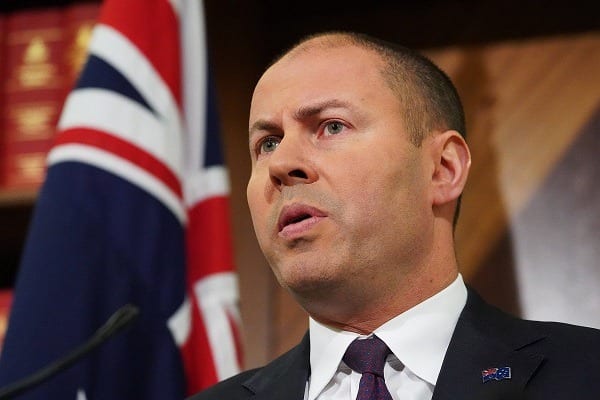I popped the cork on that bottle of champagne we ladies have been keeping on ice for exactly fifty years (since this country’s historic equal pay case established the principle of equal pay for equal work) waiting to hear the glorious news that the unjust gender pay gap had finally closed. On Monday, Treasurer Josh Frydenberg delivered the good news at Question Time.
Not sure the gender pay gap has *closed* @JoshFrydenberg If it has, someone forgot to tell the women of Australia #qt
— Katharine Murphy (@murpharoo) September 9, 2019
Oh joy! But just as I was in the thick of calculating precisely what I would do with the extra $241.50 a week women, on average, earn less than men it all came to a screeching halt.
By Tuesday, Senator Marise Payne, who also happens to be the Minister for Women, so someone we would hope knows a thing or two about this stuff (well, I guess having the word “Treasurer” in your job title should also inspire a bit of confidence you’ve got a grip on numbers, but I digress) came onto the scene to concede that, in fact, there remains a 14% gender pay gap.
He says tomato, she says there’s still a 14% gender pay gap. Awkward!
"The gender pay gap has closed and the budget is coming back to surplus for the first time in more than a decade," the treasurer @JoshFrydenberg boldly told parliament yesterday. Except the pay gap definitely hasn't closed as @MarisePayne pointed out… https://t.co/JwuW3oDlBQ
— Georgie Dent (@georgiedent) September 10, 2019
To be fair to Frydenberg, I can see how this happened. The Government and its various agencies and departments have been so busy trying to positively spin the gender pay gap, there was a real risk someone would eventually get carried away and declare it closed altogether.
First, in April the Australian Tax Office (ATO) released its annual Taxation Statistics report for 2016–17 along with a ridiculous press release crowing about the “surprising” jobs where women earn more than men. Everything’s sorted folks!
Women earn more than men in, like, two jobs. I hope you weren’t crushed by the stampede of women en-route to the surf shop to secure their future economic security, pro-surfing being among the few career prospects where women can expect to earn more than men.
Then on August 28th, Australia’s (Un)Equal Pay Day, the Office for Women put out a tweet heralding the 14% gender pay gap as “great news for Australian women”. They also trumpeted the Government’s Economic Security Statement for Women, claiming it was “improving the lives of women by opening up more opportunities and supporting pay equity”.
Spin fail: Hands up if you think the 14% gender pay gap, which has barely shifted in a year, is “Great news for Australian women”. And if you think the Economic Security Statement rife with words like choice and little time for discrimination is “improving the lives of women”. https://t.co/Tru8aBiu0q
— Kristine Ziwica (@KZiwica) August 28, 2019
Never mind that the Women’s Economic Security Statement mentions the word “discrimination” just three times, two of those in reference to Sex Discrimination Commissioner Kate Jenkins’ job title.
Meanwhile, it mentions the word “choice”, the gender pay gap being down to women’s “choices”, thirteen times. I know, I actually counted. This grand pronouncement came just a week after a Diversity Council report indicated discrimination remains the single biggest driver of the gender pay gap and its impact is growing. That’s by the by.
This prompted some to ask, “Is this a parody account?”
On Father’s Day, the Australian Bureau of Statistics joined the party by putting out a tweet spruiking the fact that the proportion of dads making use of flexible work arrangements to look after children under the age of twelve had doubled since 1996. You see, the fact that women still shoulder the lion’s share of the unpaid caring work is another major driver of the gender pay gap.
But I wouldn’t call an increase from 15% to 30% over a twenty-year period a success. In particular, given research shows that men are two times more likely to have their requests for flexible work turned down, and, according to the Workplace Gender Equality Agency, only two in 100 employers set targets for men’s engagement in flexible work. Imagine where we could be with the right government policies and workplace practices to enable men to be more engaged fathers – and women more engaged in paid work?
Tomorrow is Equal Pay Day. Ever wonder how discrimination, which research shows is a key driver, factors into Government policy to close the gap? So did I. Spoiler: Not much. It has been erased in favour of a focus on women's "choices". @WomensAgenda https://t.co/sZ9gETgnTD
— Kristine Ziwica (@KZiwica) August 27, 2019
Lastly, there’s the little matter of why the gender pay gap is, as the Government is quick to point at every available opportunity, “historically low”.
To quote the venerable Professor Rae Cooper of the University of Sydney Business School, one of the country’s foremost experts on the gender pay gap, the reason the gap is smaller is because “we are suffering chronically depressed male wages”. Essentially, men are being paid less. Women aren’t being paid more. Hence the gap is smaller. On this occasion, I would advise the blokes refrain from prematurely popping the champagne.
I’ll leave you with one final thought. I have been working up to writing a column about the growing army of “gender pay gap deniers”, those who, like climate change deniers, deny the existence of the gender pay gap and the robust evidence that underpins it. I just hadn’t expected to count our nation’s Treasurer among its ranks.
Kristine Ziwica is a regular contributor. She tweets @KZiwica


